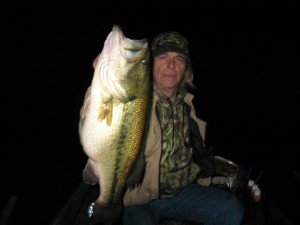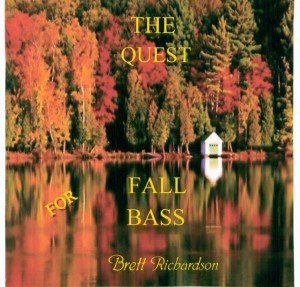Bite windows for giant fall bass can be short and intense, but this has always been my favorite season for searching for out-size fish. Between the last phase of late summer and into fall turnover, giant bass can be found locating at variable depths on waters throughout the country. While shallow water impoundments find fish locating either in heavy vegetation or on inside and outside turns on edges of expansive weed flats, deep impoundments can offer a chance at giant bass that locate on and around on off-shore structures.
During the first stage of turnover, off-shore haunts also offer topwater opportunities to boat quality largemouth and smallies. Many fish are suspending on forage pods out over main basins. During prime bite windows during the night and early morning hours, larger topwaters and wakebaits take out-size fish especially on deep clear lakes and reservoirs. Baits like Lunker Punkers, Black Dog Shellcrackers and Depps Buzz Jets are deadly options. Out-size fish will rise to the occasion from a variety of depth locations, both on off-shore structures and out in deep basins. Locate these fish with your electronics and find the schools of bait. On shallower bodies of water with heavy vegetation, focus on expansive flats, edges of flats that border the basin areas and inside and outside deep turns that cut into thick vegetation.
As the turnover progresses further, the more big fish head toward areas containing more ample oxygen supply that hold the majority of primary forage. Vegetation is starting to emit gases that push trophy bass out to areas of remaining green weeds. The pelagic summer bass have already taken up residence during the stages of summer and are already blasting bluegills out over main basins. These fish are already in position for you to capitalize on the deep water bite. Hot baits for weedy lakes when big fish start to move out to edges and steep deeper turns can be jerkbaits, spinnerbaits with single blades that can be slow-rolled, chatterbaits, and classic topwater baits such as a spittin’ Image and other classic walking baits.
 Where lakes contain rocky areas near weeds, jig combos and swim jigs always will produce big fish. Swimbaits fished on ledge zones, rip-rap and filter fingers leading quickly to deep basins are superb choices for fall turnover right into fall peak. I choose from a select group of 5 to 8 inch swimbaits since we don’t have any Florida bass in our waters. Various sizes of the 3:16 Mission Fish, Osprey Talon, and 5” Matt Lures Bluegill are my primary choices. Big northern strain bass will pound these baits either worked slowly around deep ledge areas or strolled across main lake basins that contain a variety of ingredients that hold out-size fish through the entire fall season. Over-sized musky jerkbaits such as a Maina Jake or Squirrely Burt also produce out-size bass for us year after year. Larger tubes also work well on both edges of remaining vegetation edges and on off-shore structures.
Where lakes contain rocky areas near weeds, jig combos and swim jigs always will produce big fish. Swimbaits fished on ledge zones, rip-rap and filter fingers leading quickly to deep basins are superb choices for fall turnover right into fall peak. I choose from a select group of 5 to 8 inch swimbaits since we don’t have any Florida bass in our waters. Various sizes of the 3:16 Mission Fish, Osprey Talon, and 5” Matt Lures Bluegill are my primary choices. Big northern strain bass will pound these baits either worked slowly around deep ledge areas or strolled across main lake basins that contain a variety of ingredients that hold out-size fish through the entire fall season. Over-sized musky jerkbaits such as a Maina Jake or Squirrely Burt also produce out-size bass for us year after year. Larger tubes also work well on both edges of remaining vegetation edges and on off-shore structures.
Selecting the correct baits for the exact task at hand is one of the crucial factors that will help you triple your catch rate through the stages of fall. Reading water quickly and accurately to determine big bass locations on each body of water you fish across the country, then choosing the most proficient bait for the location and activity levels of giant bass on any particular day or night should be your main focus at all times through the stages of fall.
As water temperatures drop from 58 to 54 and water layers stratify, this signals the end of turnover and time to boat big numbers of giant bass. The fall peak time frame features the largest bass in any system grouped into a few prime areas. Expect good numbers of the heaviest bass in any system you fish during the fall peak. This prime period can last anywhere from 2 weeks to 21 days or so depending on geographical location. Water temperatures that slowly drop in small increments extent the fall peak bite in certain sections of the country. My primary focus is on off-shore channel basin depressions, main lake structures with specific spots on spots and structural features that attract mid to late fall forage pods and groups of big bass. Filter fingers that lead from rip-rap areas and filter out toward the deepest sections of main lake basins hold out-size bass. Search for prime zones like these that have the quickest access to deep water in the sections of lakes and reservoirs.
 Some primary baits for either casting or strolling these zones include: heavy jig combos, swim jigs, bladed swimjigs, swimbaits, bladebaits, jigging spoons, jerkbaits in larger sizes and short-arm spinnerbaits or twin-spins. Slow falling weightless soft plastic stickbaits, such as a 7 inch Senko, work well in calm weather for deep water structure bassin’. Strolling baits through channel bends and around pelagic structure has produced many of my heaviest largemouth and smallmouths to date. When fish activity increases during primary bite windows, I can cover water on these zones and trigger multiple big bass bites. During times when trophy bass are neutral, I will always pause and dead-stick presentations on precise elements of specific structures. Spots on spots can hold good numbers of big fish, but in between prime activity levels, these fish must be triggered with a combination of various methods to produce neutral giants. A vertical fished giant tube can also trigger inactive to neutral bass on off-shore structures and in basin zones. Most big bass are grouped in specific sections of the waters you fish during fall peak, but there also can be a few loners. These lone fall season bass tend to be huge fish. They can be bass that are still heading toward prime wintering grounds or fish that have moved from tightly niched groups in search of forage just before the onset of winter.
Some primary baits for either casting or strolling these zones include: heavy jig combos, swim jigs, bladed swimjigs, swimbaits, bladebaits, jigging spoons, jerkbaits in larger sizes and short-arm spinnerbaits or twin-spins. Slow falling weightless soft plastic stickbaits, such as a 7 inch Senko, work well in calm weather for deep water structure bassin’. Strolling baits through channel bends and around pelagic structure has produced many of my heaviest largemouth and smallmouths to date. When fish activity increases during primary bite windows, I can cover water on these zones and trigger multiple big bass bites. During times when trophy bass are neutral, I will always pause and dead-stick presentations on precise elements of specific structures. Spots on spots can hold good numbers of big fish, but in between prime activity levels, these fish must be triggered with a combination of various methods to produce neutral giants. A vertical fished giant tube can also trigger inactive to neutral bass on off-shore structures and in basin zones. Most big bass are grouped in specific sections of the waters you fish during fall peak, but there also can be a few loners. These lone fall season bass tend to be huge fish. They can be bass that are still heading toward prime wintering grounds or fish that have moved from tightly niched groups in search of forage just before the onset of winter.
Most trophy bass are sitting close to bottom by this stage of the fall season, but a few tend to suspend on the last remaining forage pods a bit higher in the water column. This scenario is typical with big smallmouths in particular, but also is indicative to largemouth and spotted bass. Deep running cranks and squarebill crankbaits are another productive presentation for pelagic suspending bass through fall. I burn these baits down and dead-stick them at intervals to trigger fish higher in the water column. Working a variety of presentations for each group of fish you locate with your electronics will keep you consistent for triggering bites from fish in a variety of activity levels. After locating prime zones that hold big fall bass, revisit these areas often at different times during the day or night. Activity levels can change fast during this prime time to hunt the fish of a lifetime.
* Freelance Outdoor Writer, former In-Fisherman contributor and veteran trophy bass hunter Brett Richardson has been chasing multi-species giant fish for well over five decades.
